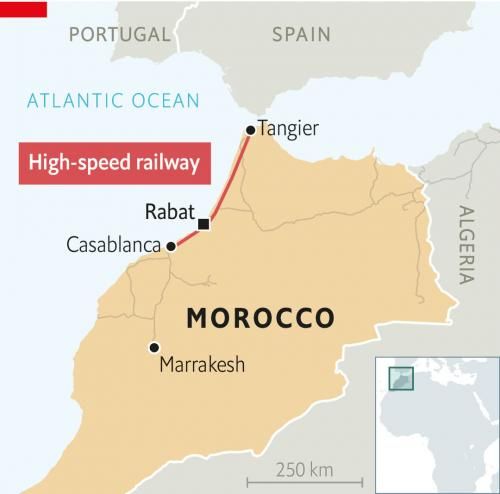The Spanish government has pledged £2M (€2.3M) towards a design study for revived plans to connect Europe to Morocco’s high speed rail network with a tunnel across the Strait of Gibraltar.
Proposals for the “Europe-Africa Gibraltar Strait fixed link” were mothballed in 2009 but revived in April of this year when the joint Spanish-Moroccan commission for the undersea tunnel project met for the first time in 14 years.
The funding will be provided through the European Union’s Recovery, Transformation & Resilience Plan and will be allocated to the Spanish Society of Studies for a Fixed Link through the Strait of Gibraltar. This group currently holds the responsibility for exploring the numerous possibilities for the project.
Studies on connecting the two continents date back to the 1930s. When Spain first proposed the tunnel in the 1930s, it hired engineers to study the geology of the crossing. A major problem arose due to the discovery that the rock under the Strait was extremely hard making tunnelling impossible with the technology of the time. This called for a proposal of a pre-fabricated concrete tunnel to be attached to the floor of the strait with cables.
However, the project was deemed to be officially initiated in 1979 when King Juan Carlos I of Spain and King Hassan I of Morocco signed an agreement to develop the project in an attempt to boost relations between Europe and Africa.
Inauguration of Morocco’s first high-speed rail line in 2018 renewed faith in the project to connect it with Spain’s own extensive high-speed rail network. Tangier serves as the starting point of the high-speed rail line in Morocco which serves both Rabat and Casablanca.
Spain’s network covers the southern coast including a stop in Malaga which is connected to Algeciras, via upgraded line capable of travelling 220km/h, where a ferry service currently operates between Tangiers. Ferry services also operate between Tarifa in Spain and Tangiers.
Speaking at the joint committee meeting, Spain’s minister of transport, mobility and urban agenda Raquel Sanchez said: “It has an important political significance that, after 14 years, since Tangiers in October 2009, we give a boost to the studies of a project of the utmost geostrategic relevance for our countries and for the relations between Europe and Africa”.
Both parties also agreed to develop a general strategy and a work plan for the next three years for the project at this meeting.
Also Read
Africa must tackle huge infrastructure gap to unlock opportunities for transformation – Report
Zero Carbon Charge mulls first solar-powered EV charging network in South Africa

